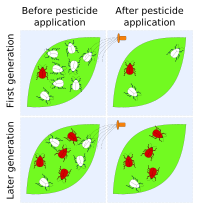
Photo from wikipedia
Abstract Crops genetically engineered to produce insecticidal proteins from the bacterium Bacillus thuringiensis (Bt) have improved pest management and reduced reliance on insecticide sprays. However, evolution of practical resistance by… Click to show full abstract
Abstract Crops genetically engineered to produce insecticidal proteins from the bacterium Bacillus thuringiensis (Bt) have improved pest management and reduced reliance on insecticide sprays. However, evolution of practical resistance by some pests has reduced the efficacy of Bt crops. We analyzed global resistance monitoring data for 24 pest species based on the first 25 yr of cultivation of Bt crops including corn, cotton, soybean, and sugarcane. Each of the 73 cases examined represents the response of one pest species in one country to one Bt toxin produced by one or more Bt crops. The cases of practical resistance rose from 3 in 2005 to 26 in 2020. Practical resistance has been documented in some populations of 11 pest species (nine lepidopterans and two coleopterans), collectively affecting nine widely used crystalline (Cry) Bt toxins in seven countries. Conversely, 30 cases reflect no decrease in susceptibility to Bt crops in populations of 16 pest species in 10 countries. The remaining 17 cases provide early warnings of resistance, which entail genetically based decreases in susceptibility without evidence of reduced field efficacy. The early warnings involve four Cry toxins and the Bt vegetative insecticidal protein Vip3Aa. Factors expected to favor sustained susceptibility include abundant refuges of non-Bt host plants, recessive inheritance of resistance, low resistance allele frequency, fitness costs, incomplete resistance, and redundant killing by multi-toxin Bt crops. Also, sufficiently abundant refuges can overcome some unfavorable conditions for other factors. These insights may help to increase the sustainability of current and future transgenic insecticidal crops.
Journal Title: Journal of Economic Entomology
Year Published: 2023
Link to full text (if available)
Share on Social Media: Sign Up to like & get
recommendations!